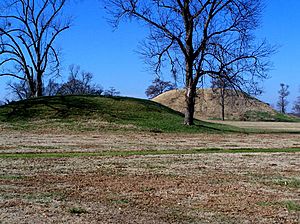Plum Bayou culture facts for kids

The Plum Bayou culture was an ancient group of Native Americans. They lived in what is now east-central Arkansas a long time ago, from about 650 to 1050 CE. This time is known as the Late Woodland Period. We know about them because archaeologists studied places like the Toltec Mounds site. The culture was named after a nearby waterway.
Contents
Who Were Their Neighbors?
The Plum Bayou culture was not the first group to live in this area. Before them came the Baytown culture (from 300 to 650 CE). After the Plum Bayou people, early Mississippian cultures began to grow. These groups thrived from about 900 to 1600 CE.
The Plum Bayou people had connections with other groups too. They knew the Coles Creek culture, who lived near the Mississippi River. They also interacted with early Caddoan cultures. These Caddoan groups lived in river valleys like the Red, Ouachita, and Arkansas River in Arkansas and Oklahoma.
People of the Plum Bayou culture traded with others. Archaeologists have found special materials at their sites. These materials came from places like the Ozark Plateau, the West Gulf Coastal Plain, and the Ouachita Mountains. This shows they traded goods over long distances.
Some important Plum Bayou sites with mounds include:
- Baytown Site
- Chandler Landing Site, in Prairie County
- Coy Site
- Dogtown Site
- Hayes Site
- Maberry Site, in Woodruff County
- Roland Site
- Toltec Mounds
Their Homes and Villages
The Plum Bayou culture was one of the first groups in this region to build special community centers. These centers had platform mounds and rectangular open areas called plazas. Most Plum Bayou people lived in small villages. These villages were found in both the higher lands and the flat areas near the White and Arkansas Rivers.
Archaeologists sort Plum Bayou settlements into different types. Some were just for one family. Others had several families. Some villages with many families also had a mound. The largest sites had multiple mounds.
What They Ate
The Plum Bayou people were farmers. They grew many different crops. These included plants like amaranth, chenopodium, bottle gourd, knotweed, little barley, maygrass, squash, sunflower, and sumpweed. At some later Plum Bayou sites, they also grew small amounts of maize (corn).
Besides farming, they also hunted animals for food. They gathered wild plants too. These included fruits like cherries, grapes, plums, and persimmons. They also collected nuts.
Their Pottery and Tools
Archaeologists learn a lot about the Plum Bayou culture from their pottery. Much of their pottery was plain. It was often made stronger by adding crushed shells to the clay.
Some types of decorated pottery found at Plum Bayou sites include Coles Creek incised var. Keyo, Larto Red, Officer Punctated, and French Fork incised. They also used a red clay paint, called red slip, to decorate some of their pots and vessels.
Why They Changed
Over time, neighboring cultures started growing more corn and developed more complex ways of life. They had more organized religions and political systems. However, the Plum Bayou people did not adopt these changes in the same way.
People continued to live in the region, but they stopped using their large ceremonial sites. We don't know exactly who the direct descendants of the Plum Bayou culture are today. However, the Quapaw people are now responsible for the human remains and artifacts from the Plum Bayou culture. This is done through a law called the Native American Graves Protection and Repatriation Act.
Images for kids
-
Toltec Mounds, the largest known Plum Bayou site




